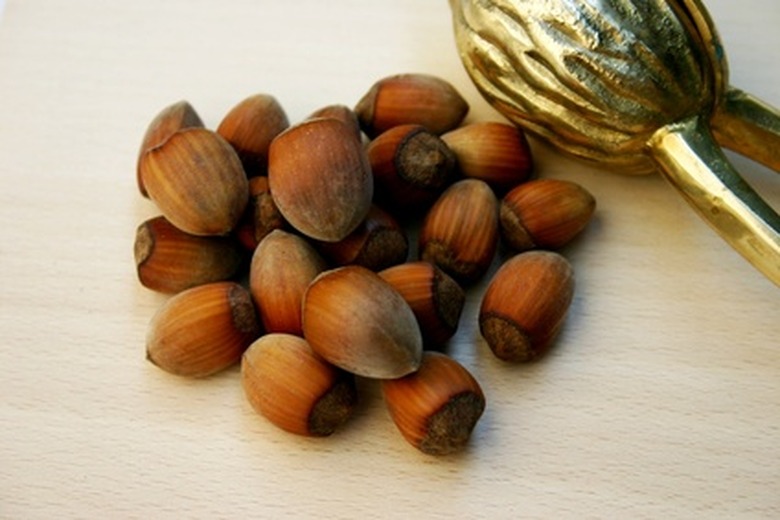Growing Hazelnut Trees In Pennsylvania
Things Needed
- Shovel
- Wood chip mulch
- Soil amendments
- 10-10-10 granular fertilizer
- Pruning saw and hand shears
Native to the eastern and central United States, the American hazelnut is hardy throughout Pennsylvania. The plant grows wild as a shrub or small tree, but is usually trained to one trunk when cultivated. Hazelnuts aren't self-pollinating; grow two varieties if you want to produce nuts. Hazelnut trees start bearing fruit when they are about six years old.
Step 1
Select one-year-old trees from nurseries. Look for trees that have a strong main trunk and healthy, green leaves. Avoid trees with spotted or scorched leaves, signs of disease or water stress.
- Native to the eastern and central United States, the American hazelnut is hardy throughout Pennsylvania.
- Hazelnuts aren't self-pollinating; grow two varieties if you want to produce nuts.
Step 2
Contact your local county extension office to obtain a soil test kit. Scoop soil samples from several areas in your yard and mail the test kit. In a few weeks, you'll receive a detailed analysis of your soil. Hazelnuts prefer slightly acidic to neutral soil (pH 4.0 to 6.0). Additionally, they must have well-drained soils and won't grow well in the dense clay soils of northeast and northwest Pennsylvania.
Step 3
Amend your soil as recommended by the soil test results to improve drainage and adjust pH level.
Step 4
Soak bare root trees in water for one hour before planting to ensure planting success. Dig a hole with your shovel as deep and twice as wide as the root ball. Turn the hazelnut tree's pot on its side and lightly tap on the container. Gently pull the tree from the pot at the point where the trunk meets the soil.
- Contact your local county extension office to obtain a soil test kit.
Step 5
Place the tree in the hole so it sits 1 inch above the surrounding ground. Back fill the hole with soil half-full. Fill the hole with water and allow it to drain. Fill the hole completely with soil and tamp down lightly to remove any air pockets.
Step 6
Keep weeds down by hand weeding or apply an herbicide designed for broad leaf plants, according to package directions. Apply 2 to 3 inches of wood chip mulch to the base of the tree to suppress weeds.
Step 7
Hand-spread 1 lb. 10-10-10 granular fertilizer around the base of the tree after planting. Thereafter, apply 1 lb. 10-10-10 fertilizer every spring until the tree is 2 years old. Then apply 1 lb. 10-10-10 fertilizer per inch of the tree's diameter, each spring. Apply fertilizer 12 inches from the trunk of the tree to the edge of the tree's canopy.
- Place the tree in the hole so it sits 1 inch above the surrounding ground.
- 10-10-10 granular fertilizer around the base of the tree after planting.
Step 8
Water young hazelnut trees weekly during dry weather, and especially in late summer as the tree produces nuts. Cut down watering to every three weeks in late fall during dry weather.
Step 9
Prune hazelnut trees in early spring. Cut out dead branches, thin, weak growth or branches that cross and rub against each other. If you're growing your hazelnut as a shrub, leave five to seven main branches and cut the rest to the ground. Cut branches larger than 1 inch with a pruning saw; cut smaller branches with hand pruning shears.
Step 10
Harvest hazelnuts in late summer to early fall when they begin to drop from the trees. A mature tree can yield as much as 10 to 15 lbs of nuts.
- Water young hazelnut trees weekly during dry weather, and especially in late summer as the tree produces nuts.
- Harvest hazelnuts in late summer to early fall when they begin to drop from the trees.
Tip
Plant hazelnuts in early spring. Choose hybrid varieties that are chestnut blight-resistant. Space trees 6 feet apart. The main challenge Pennsylvania gardeners face is giving hazelnut trees the right kind of soil. Pay special attention to amending your soil, so it is the right pH and is loamy and well-draining.
